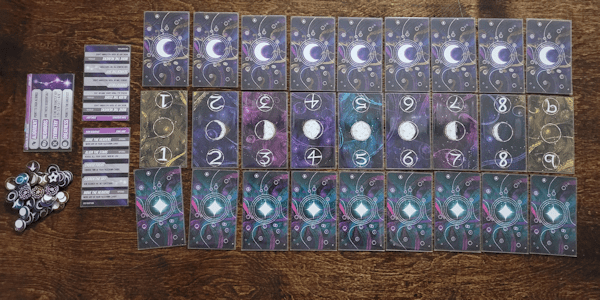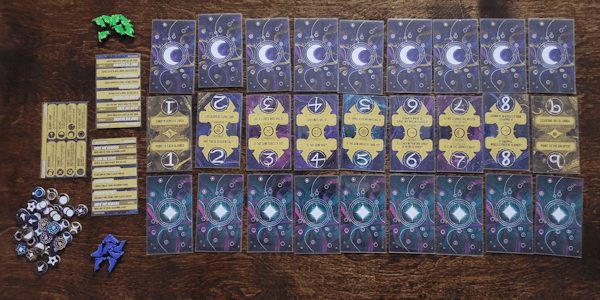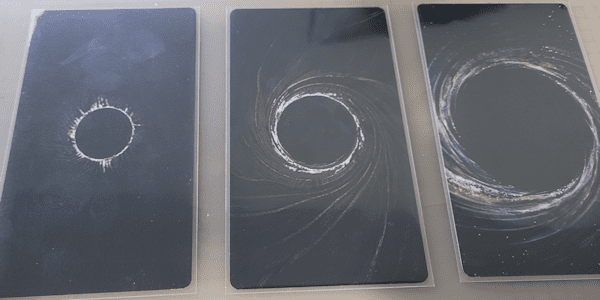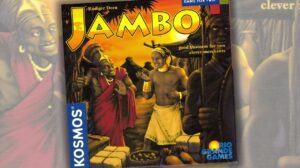Disclosure: Meeple Mountain received a free copy of this product in exchange for an honest, unbiased review. This review is not intended to be an endorsement.
Logic & Lore is a game that I knew right from the beginning my wife would love. She is someone who can sit for hours working on sudoku puzzles. So when asked if I would like to delve into this little game, it was an enthusiastic yes!
This small-box game only has a few components. Each player has a set of 12 star cards with ranks from 1 through 9, plus three black holes. There are nine alignment cards, also ranked from 1 through 9. Beyond that, there is a pool of memory tokens (36) with various symbols on them, some meeples for each player (7 per player), and reference cards (3). In the basic game, called the Star Light version, the black holes and the meeples are not used.
Star Light
To set up the basic game, the alignment cards are placed between the players ranked in order from 1 through 9 with the moon-phases face-up. Each player shuffles their star cards and deals them out face-down so that each of their cards is associated with one of the alignment cards. Make sure that the reference cards are on the Star Light side and that the memory tokens are within reach. Randomly choose a player to go first, and you are ready to begin.
Side note: there is a rule in this game that made me double-take and smile. Any player who is under the age of 10 starts the game with the star card that matches their age already face-up and aligned.

A turn consists of five steps, taken in order; only two steps are mandatory.

- Move the Heavens (optional): The active player may rearrange any or all of their face-down star cards. Star cards which are face up are locked and cannot be moved.
- Align the Stars (optional): The active player may, if they believe that all of their star cards are now in the correct order, choose to reveal them all. If the player is correct and all of their star cards match the alignment cards they are associated with, then they have won the game. If, however, any cards are in the wrong place, they have lost the game.
- Choose Focus: The active player chooses two of their face-down star cards and lifts them up so that their opponent can see them. The active player is not allowed to look at these cards.
- Search the Sky: The active player, while holding the chosen star cards so that their opponent can see them, asks the questions. The four questions must be asked in order, however questions may be skipped. The first three questions are yes/no questions—as soon as a question is answered with ‘yes’ the Search the Sky step ends, and play proceeds immediately to the final step. The four questions are:
- Are either or both of these stars aligned? If either or both of the star cards shares the rank of its alignment card, their opponent answers yes, and indicates which card is aligned (or indicates that they both are); the aligned card(s) are then flipped face-up. If neither star card shares the rank of its alignment card, the opponent answers no, and the active player may proceed to ask the next question.
- Are these stars neighbors? If the two star cards are numerical neighbors (e.g., 3 and 4, 7 and 8, etc.) the opponent answers yes. If the two star cards are not numerical neighbors, the opponent answers no, and the active player may proceed to ask the next question.
- Are these stars symmetric? Symmetry is defined as having ranks that are equally distant from the center rank of 5 (i.e., 4 and 6, 3 and 7, etc.). The easiest way to tell is if the ranks of the star cards sum to 10. If the two star cards are symmetrical, the opponent answers yes. If the two star cards are not symmetrical, the opponent answers no, and the active player may proceed to ask the next question.
- Which of these stars is greater? This is the final question, and if a player gets to this point, they are guaranteed to get some information. When asked, the opponent will point to the star card that has the greater rank.
- Move the Heavens (optional): this step is exactly like step 1, above.
Once the Search the Sky step is completed, any cards which were not revealed to be aligned are put back, face-down, where they were before step 5 begins. Given that players can rearrange their face-down star cards both at the beginning and end of their turn allows for adjustments to be made as soon as new information is gained, as well as after some time has passed to allow for contemplation.
The game ends as soon as a player has all of their cards revealed. This can happen either in step 2 or in the middle of step 4 during the Alignment question (assuming both cards are aligned, and they were the last two cards that needed to be). In either situation, a player with all of their star cards aligned wins the game. But be careful! If a player chooses to reveal their cards in step 2 and is wrong, they immediately lose, and victory goes to their opponent.
Memory Tokens
The memory tokens exist as an aid. They are placed in front of face-down star cards as a way of remembering what status a card might have. Each token has a symbol on both sides; symbols consist of four that match the Search the Sky Questions reference card (above); others symbols are based on the questions used in the advanced game. Either way, these arrows, black holes, half-moons, stars, and such can help a player keep track of what they know about a star card.

There is a limited supply of these tokens. There are no rules that would prevent you from using other small objects; in fact, the rules suggest using the meeples as memory tokens, especially if you are not playing the advanced game. Speaking of which…
Star Bright
Once you have a few games of Logic & Lore under your belt, you might want to try the more advanced version, called Star Bright. The setup for this version is almost exactly the same. The changes are:
- The alignment cards are placed between the players ranked in order from 1 through 9 with the moon-phases face-down; the cards should each display a question..
- Make sure the reference cards are on the Star Bright side.
- Each player will need their meeples.
Other than this, the setup is exactly the same.

Gameplay is the same as it is in Star Light, with two exceptions:
- There is an extra step in the sequence. Starting on the second turn, between steps 2 and 3 (i.e., after Align the Stars and before Choose Focus) there is a required step, Divine the Cosmos. In this step, the active player places one of their meeples on any alignment card excluding 1 and 9 (i.e., between 2 and 8) that does not already have a meeple on it. If all of the cards have a meeple, the active player removes an opposing meeple and replaces it with their own. Two of a player’s meeples are removed when they align a star card, meaning they have to re-earn those questions.
- During step 4, the active player does not ask the four questions from Star Light. Instead, they ask the questions on the alignment cards, in ascending numerical order. They may always ask questions 1 and 9; the remaining questions are only available if they have their meeple on the alignment card.
The questions on the alignment cards include the four Star Light questions (i.e., alignment cards 1, 2, 3, and 9). The rest can get a little trickier.
- Alignment cards 4 and 5 look at the sum of the star cards’ values and check for characteristics other than symmetry (odd/even? Greater than 10?).
- Alignment cards 6, 7, and 8 look at the location of the star cards, checking to see if the cards are on the right track to be aligned (adjacent to their desired location? On the correct half of the board?).
Black Holes
The last set of components that comes with this game are six black hole cards (three for each player). These can be added in to increase the difficulty of the game. At the start of the game, players determine how many black hole cards will be added.

The black holes are shuffled in with the player’s star cards and placed face down with the rest. For each black hole included, there will be a star card in the line that is not associated with an alignment card.
Obviously, any card off to the left or right of the alignment cards cannot be aligned. Any question asked while a black hole is in the pair of cards being examined will be answered no – black holes are never aligned, cannot be another card’s neighbor, have no value to allow for symmetry or to be greater than another star card, and so on. If two black holes are being examined, then the question of which is greater is based on the size of the black hole depicted on the card.
Final Thoughts
I have friends that love logic puzzles, especially the ones where you are trying to figure out in what order to put a group of people, identify what they are wearing or carrying, and so on. I have never been very good at those. These same friends seek out super-difficult variations on sudoku. I have never been very good at those, either.
Logic & Lore is a logic puzzle I enjoy. The fact that it comes in the form of a two-player competitive game is just a bonus. This is a puzzle that can be tough, but aloof. The information is such that I can wrap my head around it, manage the variables, and work my way to completion without feeling like things are too simple or too difficult. In the games I have played with my wife, she is still better than I am (much better), but I have earned a few victories.
It is because of those victories and how they came about that I can say that there is an element of luck in this game. For example, in one game I managed to bumble my way into getting star cards 3, 5, and 7 aligned early. With only two locations remaining where cards could be neighbors (1-2, and 8-9), I was able to cruise into a victory. Thanks to the remaining games we have played, I can say that this was a fluke.
My copy is not the final version that Kickstarter backers will receive. All I know for sure is that the box will be a little bigger and the meeples will be dragons (in my copy, they are cats). Aside from the picture on the box featuring mice and a dragon, the dragon meeples are likely to be the only place where the theme shows itself. The mice are not likely to be on star cards, alignment cards, or even the reference cards. I think that is a little sad, however, it is an abstract game—there is not really a need, I suppose.
In the end, I prefer the Star Bright version over Star Light. That said, I will gladly play either version. Interestingly, there is a note in the rules that states that the two players do not have to be playing the same version of the game; one could be playing Star Light while the other plays Star Bright. Additionally, black holes can be used with the Star Light version, and players do not have to be using the same number of black holes. If you wanted to adjust the difficulty of a game between two players of vastly different skill levels (or ages), one could play Star Light while the other played Star Bright with three black holes.
Logic & Lore is a wonderful, fun, and engaging game with a lot of variation to try. If you like logic puzzles (and even if you don’t), this is a game worth checking out.











Add Comment